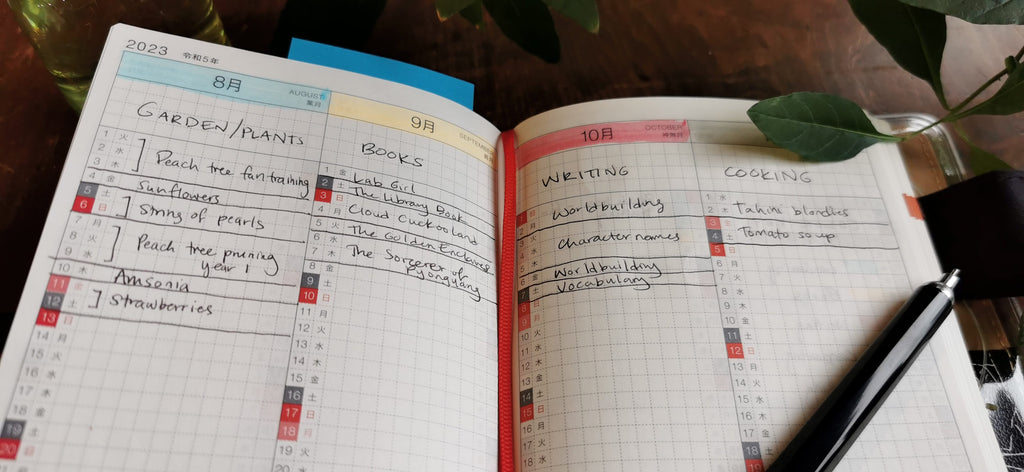Using the Hobonichi Planner as a Commonplace Book

In an earlier blog post we wrote about keeping a commonplace book, a compilation of facts, quotations, and other information that is personally meaningful to the compiler. Unlike a journal where you write your own thoughts, a commonplace book is filled with information gleaned from other sources. It’s a collection of knowledge, a personal reference book, like a dictionary or textbook filled only with the knowledge you find useful or compelling. A commonplace book is a powerful tool to help you organize and recall the things that interest you.
One challenge of keeping a commonplace book is setting up an indexing system that makes it easy to reference what you’ve recorded. The index in a commonplace book is critical to helping you look up information, but it can also be a source of confusion. How many pages should you set aside for it? How should the topics be organized? Some notebooks come with a blank table of contents, but these are usually only a page or two long, limiting how you can use them.
Today we’d like to share a great tool for commonplacing that helps solve the index problem: the Hobonichi Techo. A dated daily planner that’s popular for its flexible page format and abundance of useful details, the Hobonichi has an unusual index that makes it surprisingly well suited for commonplacing. Today we’ll be looking at how to use a Hobonichi Techo as a commonplace book.
Commonplacing with a Hobonichi Techo
The Hobonichi Techo makes a great commonplace book because of its yearly index, which spans eight pages and includes a space for each day of the year, corresponding to the daily pages of the planner. This index gives you space to write the topic of each entry in your commonplace book, with an easy way to reference its location.
Note that when you’re commonplacing in a Hobonichi, the dates of the planner don’t matter. You’ll be using them in lieu of page numbers to help you look up information, but you can use an out-of-date planner, and there’s no need to write in your commonplace book every day to keep up with the printed dates.
There are two main ways to organize your Hobonichi commonplace book: using chronological entries or dividing by subject.
Chronological entries


If you tend to gather information about a wide variety of subjects and a color key isn’t practical, the index is still very effective without color-coding. For quick reference, consider writing key words in your index listings. For instance, an entry about growing sunflowers could be indexed as “GARDENING—sunflowers.” A quote about experiencing a flow state while making art might be indexed as “CREATIVITY—flow.” Key words like these will make it quicker for you to look up entries in the index later.

Note that the first column of the Hobonichi’s index does not have corresponding daily pages (it’s devoted to the last month of the previous year), so this column will not be part of your index. If you’re using a color key, this is a great place to put it.
Dividing by subject

Say you’re writing a book, and you’re using your commonplace book to record your research about a few related topics. Or perhaps you want to use your commonplace book to keep a reading journal, a recipe log, and notes on your new birding hobby. You can devote each monthly section of your Hobonichi to a single subject, and each corresponding column in your index will be related to that subject. The advantage of this method is easy reference: you can quickly open your commonplace book to the topic you’re interested in and flip through all your notes.

A Note about the Extra Pages
As a planner, the Hobonichi Techo wasn’t designed specifically with commonplacing in mind, and it contains some additional pages that don’t ostensibly fit the purpose. The A6 Original planner has calendar pages for each month of the year, and the larger A5 Cousin size also includes a number of pages with columns for a weekly schedule.
While these pages don’t have a place in a traditional commonplace book, a little creativity can make them a useful addition! They can be a great place to keep reference lists of information you refer to frequently, or lists of books you’ve read (or those you refer to in your commonplace book), or an overview of the subjects you’ve covered in your commonplace book: anything you might want to refer to or record that doesn’t need to be organized within your indexing system.
Have you tried keeping a commonplace book? How do you use the index of your Hobonichi planner? Let us know in the comments!
Read our first blog post about commonplace books here.
And read our next post, about how to turn any kind of notebook into a commonplace book, here.



I remember keeping books like these when I was in high school. Didn’t know at the time that there was a name for it. I was just pretending to be a magazine editor and writing down everything 😁 Now I really like the idea of using the hobonichi as a commonplace planner. That’s an excellent idea!
I really like the idea of a common place book. I wish I had heard about it years ago, as I am always writing down things of interest in a variety of different subjects then misplacing where my scraps of paper are that I wrote on..even gum wrappers. I guess it’s not too late to start afresh. Thanks for the idea and explanations.
Leave a comment